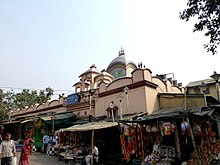Kalighat Kali Temple
| Kalighat Kali Temple | |
|---|---|
 View of the Kalighat Temple | |
| Religion | |
| Affiliation | Hinduism |
| Deity | Kali |
| Festivals | Kali Puja |
| Location | |
| Location | Kolkata |
| State | West Bengal |
| Country | |
| Geographic coordinates | 22°31′12″N 88°20′31″E / 22.52000°N 88.34194°E |
| Architecture | |
| Completed | 1809 |
| Website | |
| www | |
Kalighat Kali Temple is a Hindu temple in Kalighat, Kolkata, West Bengal, India, dedicated to the Hindu goddess Kali.[1] It is one of the 51 Shakti Pithas in eastern India.[2]
Legend
[edit]
The term Kalighat originated from the goddess Kali who resides in the temple, and Ghat (riverbank) where the temple is located.[2]
According to mythology, on learning about the death of Sati by self-immolation, Shiva was blinded in rage and started the Tandav Nritya (Dance of Destruction). To prevent the world from imminent destruction, Lord Vishnu used his Sudarshan Chakra to cut the corpse of Sati into 51 pieces, which fell in various places of the Indian subcontinent.[3] Kalighat is the site where the toes of the right foot of Dakshayani or Sati are said to have fallen.[citation needed]
History
[edit]The Kalighat Kali temple in its present form is about 200 years old, although it has been referred to in Mansar Bhasan composed in the 15th century, and Kavi Kankan Chandi in the 17th century. The present structure of the temple was completed under the Sabarna Roy Choudhury family's patronage in 1809. Santosh Roy Chowdhury, a Kali devotee himself, started the construction of the present-day temple in 1798. It took 11 years to complete the construction.[4] The factual authenticity of Roy Chowdhurys' being the traditional patron of the deity is disputed.[5] Pilgrims to the site practice a holy dipping event called Snan Yatra in the temple's Kundupukur tank.[6]
In 1835 Kashinath Roy built a Nat Mandir in the temple square. In 1843 Vaishnavite Uday Narayan Mondal, a member of the Bawali zamindar family, established the present day ShyamRai temple in the Kalighat temple square. In 1858 a Dal Mancha was installed by Madan Gopal Koley for the ShyamRai temple.[7][8]
See also
[edit]References
[edit]- ^ Balakrishnan, S (9 May 2003). "Kali Mandir of Kolkata". The Hindu. Archived from the original on 30 June 2003. Retrieved 10 November 2009.
- ^ a b Paul, Santanu (25 July 2022). "Kalighat Kali Temple, the famous shakti peeth of Eastern India". Bengal Chronicle. Retrieved 9 January 2024.
- ^ Alightindia. "List of 51 Shakti Peetha in India". List of 51 Shakti Peetha in India. Retrieved 9 January 2024.
- ^ "History". Kalighat Kali Temple. Retrieved 30 January 2023.
- ^ Moodie, Deonnie (6 November 2018). The Making of a Modern Temple and a Hindu City: Kalighat and Kolkata. Oxford University Press. ISBN 978-0-19-088528-1.
- ^ Karkar, S.C. (2009). The Top Ten Temple Towns of India. Kolkota: Mark Age Publication. p. 91. ISBN 978-81-87952-12-1.
- ^ Gangopadhyay, Sri Bipul Kumar (3 October 2005). অলৌকিক লীলায় শ্রীরামকৃষ্ণ, মা সারদা, স্বামীজী (প্রথম খন্ড) (in Bengali). Jaytara Publishers. p. 222.
- ^ Cakrabartī, Sunīla (1969). Lokāẏata Bāṃlā (in Bengali). Kalyāṇī Prakāśana. p. 38.
Further reading
[edit]- Rachel Fell McDermott; Jeffrey John Kripal (2005). Encountering Kali: In the Margins, at the Center, in the West. Motilal Banarsidass. ISBN 978-81-208-2041-8.


